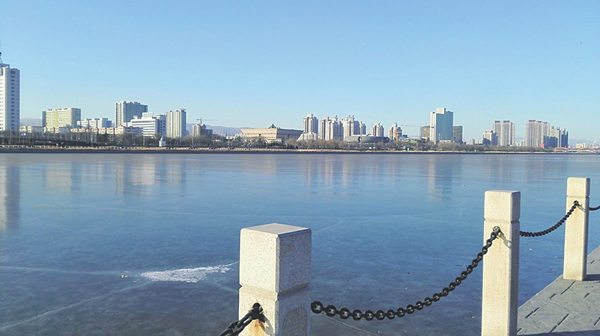Shanxi ramps up its green, low-carbon development
Updated: 2023-12-28

A wide view of the frozen Fenhe River. [Photo/Shanxi Economic Daily]
North China's Shanxi province has fully committed itself to environmental protection and has also accelerated the promotion of its green and low-carbon development – an undertaking it's rigorously pursued in recent years.
It's focused on treating of the Fenhe River, which is core to the task of establishing an important experimental zone for ecological protection and high-quality development in the Yellow River basin.
What's more, the province has implemented major water conservation and ecological environmental protection projects.
Key tasks include water resource utilization, water pollution prevention and controls and water ecological governance.
To that end, Shanxi's provincial ecology and environment department has introduced an ecological compensation mechanism for the upper and lower reaches of the Fenhe River basin.
This closely monitors water quality and promotes the improvement of the river's environment through a system of rewards and punishment measures.
To improve air quality, Shanxi has rolled out measures in five areas – including optimizing and adjusting its industrial infrastructure and promoting the green and low-carbon transformation of energy – to tackle fundamental regional atmospheric problems.
Focusing on dust pollution, it has organized urban dust control campaigns – addressing uncontrolled dust emissions from construction sites, roads, bare land, stockyards and local manufacturers. To tackle pollution in key industries, efforts have made to speed up the introduction of ultra-low emissions and deep pollution controls.
It has accelerated the control of soil pollution sources by organizing inspections of soil pollution hazards at key sites. With a focus on ensuring the quality of agricultural products and the safety of living environments, moves have been made to safeguard the food security and residential safety of the general public.
To realize the dual carbon goals of peak emissions before 2030 and carbon neutrality before 2060, the province has rigorously undertaken measures to advance its overall green and low-carbon transformation and development.
In 2022, Shanxi's Taiyuan and Changzhi cities were selected as pilot cities for climate investment and financing in China. They've since promoted six major projects, including adjusting their industrial structures to reduce carbon emissions and optimizing their energy structures to decarbonize themselves.
The cities have also coordinated pollution reductions and efficiency enhancements, promoted resource recycling developments to assist in carbon reductions, enhanced infrastructure resilience, and restored and protected their ecosystems.
These initiatives have won plaudits and are widely said to have brought new opportunities for Shanxi to respond to climate change and promote its green and low-carbon development.
Meanwhile, the counties of Loufan, Lingqiu, and Yuxian in the province were selected as national-level demonstration areas for the construction of an ecological civilization – China's environmental strategy for balanced and sustainable development.
Adding to the momentum, the Taiyuan West Mountain Ecological Culture and Tourism Demonstration Zone and Zuoquan county were rated as practical innovation bases for the guiding national environmental concept that "lucid waters and lush mountains are invaluable assets."



